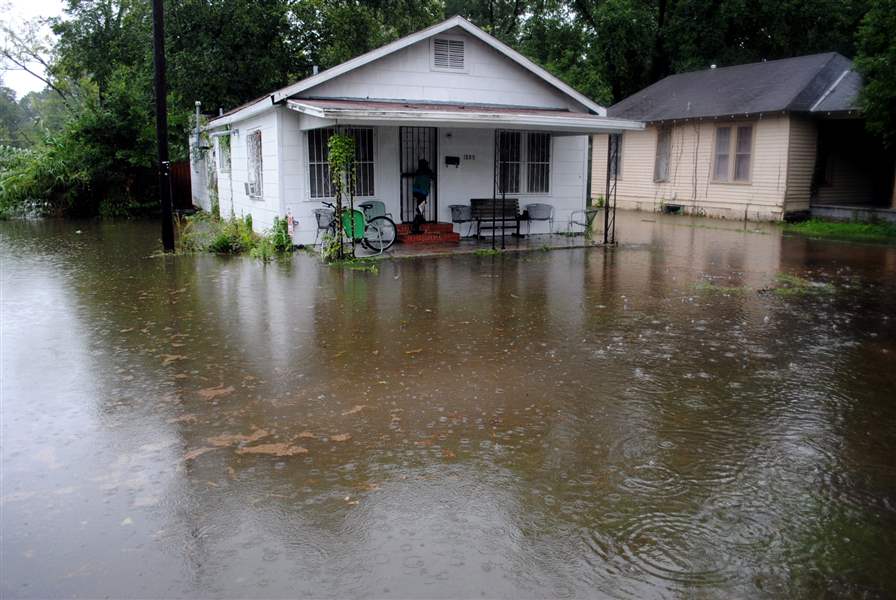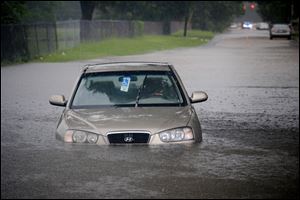
South Louisianans blame post-Katrina fixes for floods
9/5/2012
Water surrounds homes in Selma., Ala., which sits along the Alabama River. The National Weather Service said streets were flooded 3 feet deep on Tuesday.
Associated Press

A car sits abandoned in floodwaters that cover its tires in Selma, Ala. Remnants of Hurricane Isaac dumped torrents of rain on Alabama Tuesday.
LAPLACE, La. -- At the urging of residents who long have felt forgotten in the shadow of more densely populated New Orleans, the Army Corps of Engineers says it will look into whether the city's fortified defenses pushed floodwaters provoked by Hurricane Isaac into outlying areas.
However, the corps has said it is unlikely scientific analysis will confirm the theory, suggested not only by locals, but by some of the state's most powerful politicians.
Instead, weather experts say a rare set of circumstances -- not the flood walls around New Orleans' metro area -- had more to do with flooding neighborhoods that in recent years never have been underwater from storm surge.
Isaac was a large, slow-moving storm that wobbled across the state's coast for about 2 1/2 days, pumping water into back bays and lakes and leaving thousands of residents under water outside the massive levee system protecting metro New Orleans.
It was blamed for seven deaths and the damage of thousands of homes on the Gulf Coast.
Meanwhile, remnants of Isaac dumped torrents of rain on the South on Tuesday.
In parts of western and southern Alabama, roads were covered with as much as 3 feet of water.
In Louisiana, the corps' study was prompted by the suggestion that Isaac's surge bounced off levees and floodgates built since Hurricane Katrina in 2005 and walloped communities outside the city's ramparts.

Water surrounds homes in Selma., Ala., which sits along the Alabama River. The National Weather Service said streets were flooded 3 feet deep on Tuesday.
Blaming the Army Corps of Engineers is nothing new in southern Louisiana, a region both dependent on the corps and distrustful of an agency that wields great power in this world of harbors, wetlands, rivers, and lakes, all of which fall under its jurisdiction.
The corps was roundly criticized after Katrina, which pushed in enough water to break through the levees around New Orleans. Much of the city was under water, and since then the government has spent millions to rebuild the flood-wall system protecting the metro area.
Before, the corps was blamed for the unraveling of coastal marshes for building levees on the Mississippi River.
In towns including the bedroom community of LaPlace, people want answers. There, communities were under water even though they had never before flooded from storm surge.
"It has a lot of us questioning," said Ed Powell, 47, an airport emergency worker who's lived in LaPlace for 15 years and never had seen flooding on his street until Isaac hit.
Friday, U.S. Sen. David Vitter (R., La.) asked the corps to seek an independent study to decide if the new flood walls, gates, and higher levees around metro New Orleans caused water to stack up elsewhere.
Isaac came ashore as a Category 1 storm, but that classification is based on wind speed, not surge predictions. In the past, much stronger storms have wrought much smaller surge levels. Isaac had a broad wind field -- at times, more than 200 miles from its center -- that made it capable of scooping up a lot of water, said James Franklin, chief of hurricane operations at the National Hurricane Center.
"It was like scooping up water with a broad shovel rather than a pencil point," he said.
Plus, the storm's size, slow speed, and the way it angled into the state "worked together to produce incredibly high surge," said Jamie Rhome, a surge specialist with the National Hurricane Center. "The water piled up."
Helped by a declaration of a state health emergency, Louisiana officials pressed forward with cleanup from Isaac. They reported electrical power had been restored substantially throughout the state.
A spokesman for the state's unified command group estimated 95 percent of all electrical power had been returned. Utility Entergy placed the number of customers without power at 56,807.
Meanwhile, officials in Hancock County, Mississippi, were removing the carcasses of 15,000 to 16,000 nutria killed by the storm. Workers in hazardous material suits were loading the bodies of the waterborne rodents for removal to a landfill, Brian Adam of the Emergency Management Agency said by telephone.
The nutria washed up on beaches from the marshy areas where they normally live.
U.S. Environmental Services will dump the carcasses in a landfill rated to take household garbage.
Hancock County Supervisor David Yarborough said crews tried to deal with a similar problem after Hurricane Gustav, and many got sick.
Neighboring Harrison County has fewer dead nutria. Officials say county crews removed nearly 16 tons of dead animals from its beaches Saturday and Sunday.